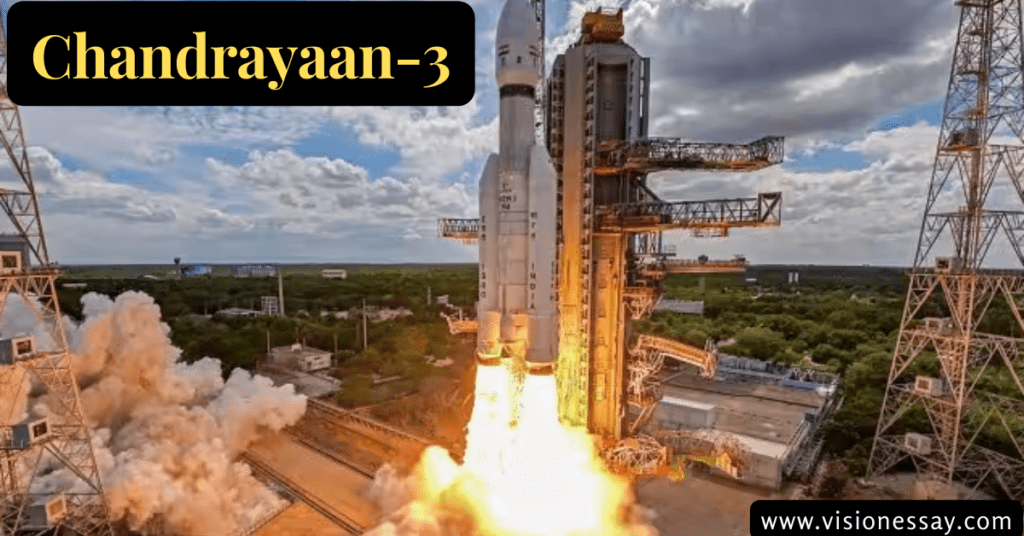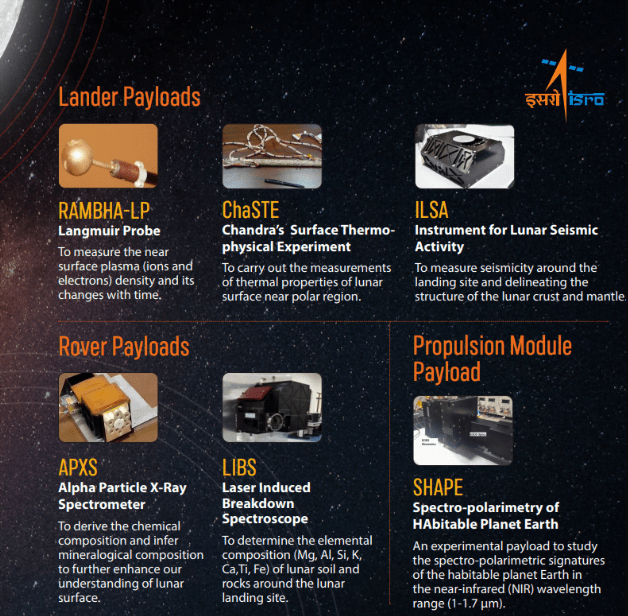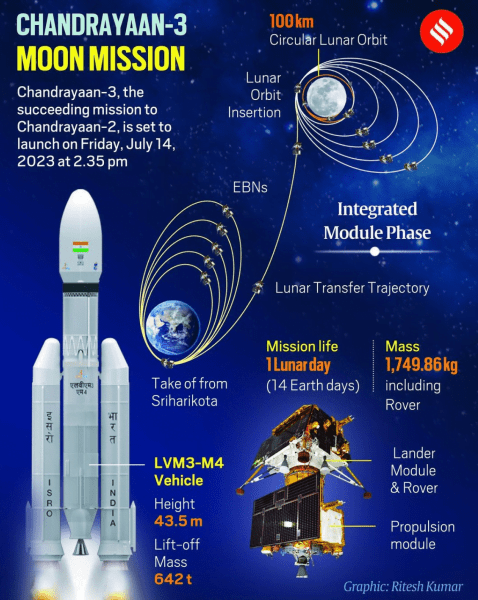
Introduction
The Indian Space Research Organization (ISRO) has launched Chandrayaan 3 in an effort to make an accurate soft landing on the moon. India wants to join China, the United States, and Russia as the fourth nation in the world to accomplish this accomplishment.
What is Chandrayaan 3 Mission?
- India’s third lunar mission, Chandrayaan 3, marks the country’s second attempt at a gentle lunar landing.
- On July 14, 2023, at 2:35 p.m., the mission departed from the Satish Dhawan Space Center (SDSC) in Sriharikota.
- With the aim of researching and showcasing new technology necessary for interplanetary missions, it comprises an indigenous Lander module (LM), Propulsion module (PM), and Rover.
Also Read: What is ISRO Aditya-L1 Mission?
What are the Mission Objectives of Chandrayaan 3?
- To show a Safe and Soft Landing on the Surface of the Moon.
- To show off the moon’s rover roaming.
- To carry out in-situ scientific research.
What are the Features of Chandryan 3?
- The Chandrayaan 3 mission will use the identical lander (Vikram) and rover (Pragyan) payloads as the Chandrayaan 2 mission.
- The lander’s research packages are designed to investigate a variety of elements of the lunar environment. As part of these payloads, the moon’s quakes, temperature characteristics, changes in the plasma near the surface, and the precise measurement of their separation from Earth are all being studied.
- A brand-new experiment dubbed Spectro-polarimetry of Habitable Planet Earth (SHAPE) is part of Chandrayaan 3’s propulsion module.
- By examining reflected light, SHAPE seeks to find potentially habitable smaller planets.

What Changes and Improvements in Chandrayaan 3?
- With the freedom to land safely inside a wider permitted region, the landing area has been enlarged.
- In order to go farther to the landing site or other areas, the lander has been given extra fuel.
- In contrast to Chandrayaan 2, which only had two sides with solar panels, Chandrayaan 3 had panels on all four sides.
- The landing site was selected using high-resolution photos from the Chandrayaan 2 spacecraft, and physical changes were made to increase stability and sturdiness.
- Chandrayaan 3 is equipped with additional navigational and guiding tools that allow it to continually track the Lander’s speed and make any required adjustments.
- In order to determine the speed of the Lander, a device called the Laser Doppler Velocimeter will fire laser beams onto the lunar surface.
What are Launch and Timeline?
- Chandrayaan 3 was successfully launched using the LVM3 M4 rocket.
- The LVM-3 spacecraft detached from the launch vehicle 16 minutes after launch. It started an EPO or elliptic parking orbit.
- According to estimates, Chandrayaan 3 will travel for around 42 days, and its lunar dawn touchdown is set for August 23, 2023.
- As they run on solar power, the lander and rover will have a mission life of one lunar day (about 14 days on Earth).
- Near the lunar south pole is where Chandrayaan 3 will touch down.

What is the Purpose of Landing Near the Lunar South Pole?
- Due to its excellent geography and operational circumstances, the equatorial area has historically been the main objective of spacecraft missions to the Moon.
- In contrast to the equatorial zone, the lunar south pole offers a very diverse and more difficult landscape.
- In certain polar locations, where sunlight is limited, there are zones that are always dark and have temperatures as low as -230 degrees Celsius.
- Extreme cold and a lack of sunshine make it difficult for instruments to operate and be sustained.
- Although the lunar south pole presents difficult conditions for people, it also makes them possible archives of important knowledge about the early Solar System.
- Exploring this area is essential because it may influence future deep space missions.
What are the other Chandrayaan missions of India?
Chandrayaan 1
- With Chandrayaan 1, an effort to map the moon’s minerals and produce a three-dimensional atlas of the moon, India’s lunar research missions got underway.
- Launch Vehicle is PSLV–C11.
- Chandrayaan 1 produced important findings, such as the finding of hydroxyl and water on the lunar surface.
Chandrayaan 2: Partial Success and Discoveries
- The Orbiter, Lander, and Rover on Chandrayaan 2 were designed to investigate the lunar south pole.
- Launch Vehicle is GSLV MkIII-M1.
- Despite the fact that the lander and rover crashed on the moon’s surface, the orbiter was able to gather data and discover water signals at all latitudes.
Conclusion
An important milestone for the Indian space program was reached with the Chandrayaan 3 mission. It is a noteworthy advancement for India’s space program and demonstrates the country’s commitment to space research and discovery.
Frequently Asked Questions (FAQs)
When Chandrayaan 3 will reach Moon?
After a 40-day voyage, Chandrayaan 3 is anticipated to touch down on the lunar surface around August 23. On the other side, Luna-25 will arrive at the moon two days before Chandrayaan-3, around August 21.
What will Chandrayaan 3 do on Moon?
ISRO’s Chandrayaan 3 mission has three goals: getting a lander to land softly and safely on the Moon’s surface, watching and demonstrating the rover’s ability to loiter on the Moon, and on-site observation and conducting experiments on materials found on the Moon’s surface.
Did Chandrayaan 3 enter Moon orbit?
After being launched on July 14 for many weeks, Chandrayaan 3 entered lunar orbit on August 5. The spacecraft’s lunar orbit was 164 km x 18, 074 km after the orbit decreased on August 5. Following the maneuver on August 6, Chandrayaan-3’s lunar orbit shrank even further, to 170 km x 4,313 km.
Why Luna-25 is faster than Chandrayaan 3?
Here are the main two justifications. One is that Luna-25 is substantially lighter than Chandrayaan-3, allowing it to move more quickly. Two, Luna-25 has no issues with fuel economy because it can store more fuel. Luna-25 is much lighter than Chandrayaan 3, which weighs 3,900 kg.
Sources:
- Chandrayaan-3 – Wikipedia
- Chandrayaan-3 Details (isro.gov.in)
- Chandrayaan-3 mission: All you need to know about the landing (indianexpress.com)
- doc2023825244401.pdf (pib.gov.in)
- Chandrayaan-3: India makes historic landing near Moon’s south pole – BBC News
- What India’s Chandrayaan-3 found on the moon — and what’s next | CNN
